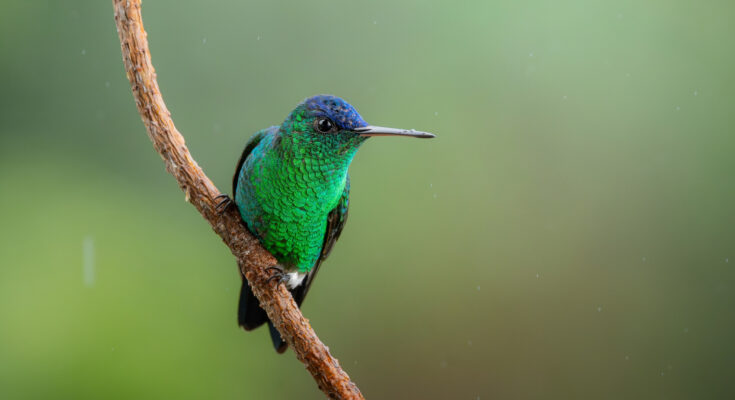The Fastest-Growing Flowers To Plant In Spring To Attract Colorful Hummingbirds
From the brightly-colored and ubiquitous ruby-throated hummingbird to the more elusive, mountain-inhabiting calliope hummingbird, there are many of these tiny, fluttering birds that spend spring and summer in the U.S. These little birds depend heavily on the nectar from their favorite flowers, especially when they migrate down south at the end of summer. Any gardener looking to invite hummingbirds of all shades to their yard needs to have a few flowers that hummingbirds absolutely love in their wheelhouse. If you want to see more hummingbirds sooner than later, consider planting fast-growing flowers in spring, like million bells (Calibrachoa x hybrida), jewelweed (Impatiens capensis), and petunias.
To get a move on attracting hummingbirds to your garden, you want to begin as soon as possible. These are the fastest-growing flowers you can plant in spring, which will begin blooming and providing vital nectar before you even know it. While you should definitely include some red-colored flowers, which hummingbirds are known to enjoy, they feed from other colors, too. Tubular flowers are also a favorite, but not a requirement to attract hummingbirds.
Entice hummingbirds with a coral honeysuckle vine
Vines like coral honeysuckle (Lonicera sempervirens) make good alternatives for invasive English ivy in your garden, plus they attract hummingbirds with tasty nectar. This quick-growing, but non-invasive vine, is native to the southeastern U.S. and hardy from zones 4 through 9. Grow it for a natural privacy cover, as it can easily reach 20 feet tall and 6 feet wide. Also known as trumpet honeysuckle, it features lovely, trumpet-shaped flowers with narrow openings ideal for hummingbird’s long beaks. These bloom between March and July, providing an excellent nectar source for many months.
Add phlox to a shady spot for shy hummingbirds
Bring hummingbirds to the shaded areas of your garden with phlox (Phlox drummondii), also known as pride of Texas. This annual species is native to meadows in Texas and grows quickly in sandy soil. You can grow this pollinator-friendly flower, hardy in zones 2 through 11, in partial shade or full sun. The rapid growth of this flower, which are trumpet-shaped with narrow tubes, makes it popular among pollinators like hummingbirds. Hummingbirds can enjoy the nectar from its blooms regularly from May until July.
Grow million bells for a heat-resistant nectar-source
Don’t mistake these adorable little flowers for petunias, despite their resemblance, because they have a character all their own. It’s native to South and Central America and produce gorgeous, bell-shaped flowers from late spring until the first frost in shades like blue, violet, magenta, and red. Hardy through zones 7 to 11, million bells are a heat-resistant, quick-growing option for attracting hummingbirds.
Sow low-maintenance zinnias for more hummingbirds
Adding zinnias to your garden beds provides continuous nectar throughout the summer and fall. This tall, colorful annual grows rapidly once planted, has deer and drought tolerance, and is an easy option for different soil types. Growing this flower is a good move for hummingbirds, especially if you choose single-flowering types that they can access readily. Hardy from zones 2 through 11, zinnias come in various colors, but prioritize red to attract more hummingbirds.
Add jewelweed to your gardener’s toolbox
Plant this fast-growing annual in spring for gorgeous gold and orange blooms in the summer and fall. Jewelweed is a native flower of the Impatiens genus that often grows in moist bogs and streams. You can both suppress weeds and attract pollinators with this jewel-toned plant that displays unique flowers shaped like little cornucopias. Each bloom offers up an inviting bounty for hungry hummingbirds to reach with their long beaks. In fact, while other pollinators visit this species, hummingbirds are well-adapted to its unique shape. Jewelweed is hardy in zones 2 through 11.
Create a paradise for hummingbirds with Mexican sunflowers
Bring many pollinators, including hummingbirds, to your yard with Mexican sunflower (Tithonia rotundifolia), a showy species with orange-red flowers. This annual flower blooms from mid-summer until early frost, doing best in the poorest soils so you can plant it in drier areas that you might have difficulty typically planting in. Start them from seed after your last frost date in springtime, choosing a spot in full sun. Add it to the back of your pollinator garden to frame shorter plants.
Plant pretty petunias to please all pollinators
Don’t forget about ground covers when it comes to planting flowers for hummingbirds. Common garden petunias are a fast-growing ground cover that will attract hummingbirds and pollinators to your yard. They also grow well cascading out of hanging baskets, making it easy for hummingbirds to feed from them. Planting petunias in spring, prioritizing full sun or partial shade, along with well-drained soil. Along with being a favorite of hummingbirds and other pollinators, petunias have a long, consistent blooming period for reliable nectar.
Add bright red scarlet sage, a hummingbird favorite
A brilliant perennial species that hummingbirds love, scarlet sage (Salvia splendens) grows tubular-shaped flowers that bloom continuously throughout the summer if you make sure to pinch off spent ones. These flowers range from red to scarlet and grow along vertical stalks. A native to Brazil, scarlet sage is most often grown as an annual in the U.S., but is hardy in zones 10 and 11. An easy plant to establish given good-draining soil, it grows rapidly and requires little maintenance.
Grow dainty hollyhock to impress hummingbirds
This popular and showy species ranges in shade from white to yellow to red. Hollyhock (Alcea rosea) is native to Turkey, but is hardy in the U.S. in zones 5 through 9. Hummingbirds suck up nectar from the large, funnel-shaped flowers which grow on stalks and bloom from June to August. A short-lived perennial, hollyhock grows rapidly, and often can reseed for the following year if left alone at the end of the growing season. Avoid some common problems when growing hollyhocks and select a spot in a moist, nutrient-rich area of your garden.
